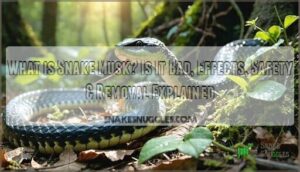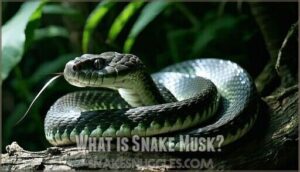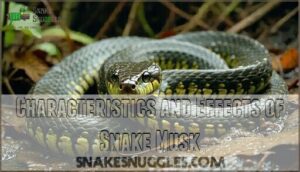This site is supported by our readers. We may earn a commission, at no cost to you, if you purchase through links.

But snake musk isn’t only a test of your nose. Understanding what it is, why snakes use it, and how it affects you can make the difference between a brief surprise and a lasting problem.
Table Of Contents
Key Takeaways
- Snake musk is a pungent, non-venomous secretion from cloacal glands that snakes release when threatened, designed to repel predators with a foul odor resembling rotten eggs or skunk spray.
- The musk won’t poison you or cause serious health problems, though it may cause minor skin irritation or temporary eye discomfort if sprayed directly at your face.
- You can avoid getting musked by moving slowly around snakes, watching for stress signals like coiling or tongue flicking, and wearing protective gear when handling them.
- Removing the stubborn odor requires patience and thorough cleaning with soap and water, vinegar, or baking soda, since the smell can persist for weeks or months without proper treatment.
What is Snake Musk is It Bad?
Ever caught a whiff of something so funky you’d to check your shoes—and then realized the culprit was a snake doing what snakes do best when spooked? That’s snake musk, a foul-smelling liquid with a notorious odor profile. Its composition varies by species, but the defensive purpose stays the same: deter threats.
Young snakes tend to musk more, though adults aren’t shy about it either. For you, the smell is hard to miss—think rotten eggs or skunk spray. Human sensitivity to snake musk characteristics makes encounters memorable.
What is Snake Musk?
If you’ve ever wondered what gives snakes their unmistakable stench when startled, snake musk is the culprit behind that powerful, lingering odor. This foul-smelling substance is produced through glandular secretions from the snake’s cloacal glands, located near the base of the tail.
Musk composition and consistency can shift between species—sometimes it’s runny and milky, other times it’s sticky and thick. The musk purpose is clear: repel threats by making the snake far less appealing.
Snake musk production ramps up when the animal feels cornered, and it can be directed at a specific target or simply released into the air.
Characteristics and Effects of Snake Musk
You’ll notice snake musk characteristics the moment a threatened snake releases its pungent aroma—a blend of foul odor, musk composition, and waste products. This defensive mechanism isn’t just about smell; human exposure can cause skin irritation, and the snake musk smell clings stubbornly to clothing. For instance, some species produce musk so strong it saturates the air for months.
Beyond the physiological impacts, these secretions play an important ecological role, warning off predators and signaling stress to other snakes nearby. Dice snakes, for example, display death feigning behavior alongside musking as a defense mechanism.
Avoiding Snake Musk
After learning just how stubborn and smelly snake musk can be, you’ll want a few tricks up your sleeve to steer clear of that lingering funk. Start with Safe Interaction—move slowly and confidently, like you’re reading the snake’s mood. Snakes pick up on nervous energy, so calm hands often mean a calm reptile.
Protective Gear, such as gloves or long sleeves, acts like armor against unexpected defense mechanisms. Pay attention to Habitat Awareness; knowing where a snake likes to hide helps you avoid surprise encounters.
Observe Snake Behavior closely—if you see tongue flicking or coiling, that’s your cue to back off. For those working with captive snakes, a quiet environment reduces stress and musking. And don’t forget First Aid basics: if musking does happen, quick action keeps the situation under control.
Removing Snake Musk
When snake musk finds its way onto your skin or clothes, tackling that stubborn odor takes a bit of know-how and patience. Start with soap and water—this classic combo works well for most affected surface types. If the smell lingers, try DIY removal tips like using vinegar or baking soda, two reliable odor neutralization methods. Good airflow speeds up the process, so crack a window or two.
For cars or carpets, sometimes only professional cleaning services can get the job done. Musk Removal Products designed for odor removal can help if household options fall short.
Here’s your quick cleanup checklist:
- Wash thoroughly with soap and water.
- Apply vinegar or baking soda for tough odors.
- Ventilate the area well.
Comparison to Other Substances and Perfumes
For anyone curious about the scent profile and purpose of musk, comparing snake musk to other substances tells a revealing story. Chemical differences set snake musk apart: it’s designed by evolution as a repellent, not as an alluring fragrance. Think pungent, skunk-like, or reminiscent of rotten eggs—certainly not a top note you’d bottle. Snakes release musk when threatened, and it acts as a potent defense mechanism, as their musk glands are uniquely adapted.
While animal musk from musk deer, civet cats, and beavers once formed the backbone of the perfume industry, strict ethical sourcing rules and the rise of synthetic alternatives have nearly erased their use.
Here’s how these sources stack up:
| Source | Typical Scent Profile |
|---|---|
| Animal musk | Warm, rich, powdery, long-lasting |
| Snake musk | Skunky, rotten, sharply repellent |
Today, synthetic musk delivers the aroma people want—without risk, or the stench.
Frequently Asked Questions (FAQs)
Is snake musk venomous?
If snake musk were venomous, you’d see headlines about “stinky snake bites.” Musk vs. Venom: musk isn’t toxic.
Exposure symptoms include irritation, not poisoning. No medical treatment needed—just soap, water, and patience for removal.
Do snakes smell like musk?
You’ll notice that not all snakes carry a strong musky odor, but some species are famous for their foul musk smell.
Musk odor intensity varies by species, gland location, and even your own musk detection ability.
Does musk protect snakes?
Imagine a predator’s nose curling in protest—snake musk is that powerful. As a defense mechanism, its pungent odor triggers predator aversion, acts as an alarm signal, and even shows insecticidal effects, reinforcing its critical ecological role.
Snake musk is a powerful defense mechanism that triggers predator aversion through its pungent odor and serves ecological roles including alarm signaling
What is Rattlesnake musk?
Rattlesnake musk is a pungent reptile secretion released from cloacal glands as a defense mechanism.
Its odor repels predators, and the musk chemical makeup can cause conjunctivitis risks if sprayed at close musk spray distance.
Why do snakes musk?
You’ll see musk released during a threat response, acting as a predator deterrent. This defensive adaptation in snakes plays an ecological role, signaling conspecifics and using unique musk composition for effective predator deterrence and snake behavior and defense.
What is snake musk?
Snake musk is a pungent reptile secretion produced by cloacal glands as a defensive mechanism.
Its musk composition and consistency vary by species, serving an ecological role in snake musk production and predator deterrence through musk glands.
Can snake musk harm humans?
If you’re worried about musk toxicity, relax—snake musk won’t cause health problems or long-term effects.
The main issue is odor persistence. Ocular exposure can irritate, and allergic reactions are rare.
Practice reptile care precautions to avoid trouble.
How long does snake musk last?
That persistent, foul odor from snake musk can stick around for weeks or even months without proper cleaning.
Environmental factors and species variation affect musk persistence, but odor duration depends mainly on your removal efforts—soap, water, and patience are essential.
Can snake musk cause health problems?
Good news: snake musk won’t poison you. Most people experience nothing more than a strong odor, though some report minor skin irritation.
Ocular exposure—musk hitting your eyes—can cause temporary discomfort and blurred vision, but symptoms resolve quickly with rinsing. No long-term effects have been documented.
What animals use snake musk for defense?
Most snake species rely on musk as an antipredator adaptation. When threatened, they release this pungent secretion to trigger predator aversion and send alarm signals to nearby conspecifics, warning them of danger.
Some musk even shows insecticidal effects against fire ants.
Conclusion
Think of snake musk like nature’s smoke alarm—loud, unmistakable, and impossible to ignore when it goes off. Now that you understand what snake musk is, you’re better equipped to manage encounters with these reptiles.
The odor won’t harm you, but respecting a snake’s space keeps both of you safer. If musk does find you, don’t panic—patience and the right cleaning methods will restore your peace. Knowledge turns an unsettling experience into just another wild story worth sharing.










